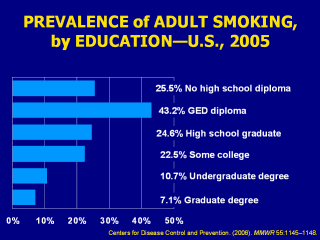| front |1 |2 |3 |4 |5 |6 |7 |8 |9 |10 |11 |12 |13 |14 |15 |16 |17 |18 |19 |20 |21 |22 |23 |24 |25 |26 |27 |28 |29 |30 |31 |32 |33 |34 |35 |36 |37 |38 |review |
 |
In 2005, the prevalence of current smoking1 in
the U.S. was highest among adults (aged 25 years or older) who had received
a General Educational Development (GED) diploma (43.2%). Persons with a
graduate degree (masters, professional, or doctorate) had the lowest
prevalence (7.1%) (CDC, 2006). Also notable is the fact that the prevalence of adult smoking is associated with poverty level. The prevalence is 20.6% for persons who are at or above the poverty level and 29.9% for persons who are below the poverty level (CDC, 2006). The smoking prevalence is 24.4% for persons aged 18–24; 24.1% for persons aged 25–44; 21.9% for persons aged 45–64; and 8.6% for persons at least 65 years of age (CDC, 2006). 1Current smokers: persons who reported having smoked 100 or more cigarettes during their lifetime and who smoked every day or some days at the time of the interview. Centers for Disease Control and Prevention. (2006). Tobacco use among adults—United States, 2005. MMWR 55:1145–1148. Slide is used with permission, Rx for Change: Clinician-Assisted Tobacco Cessation. Copyright © 1999-2007 The Regents of the University of California, University of Southern California, and Western University of Health Sciences. All rights reserved. |